-
Paper Information
- Paper Submission
-
Journal Information
- About This Journal
- Editorial Board
- Current Issue
- Archive
- Author Guidelines
- Contact Us
International Journal of Control Science and Engineering
p-ISSN: 2168-4952 e-ISSN: 2168-4960
2021; 11(1): 9-16
doi:10.5923/j.control.20211101.02
Received: Aug. 1, 2021; Accepted: Aug. 28, 2021; Published: Sep. 15, 2021

Energy - Efficient Smart Traffic Lights Design Based on Optimization of Sun’s Radiation
Osigbemeh M. S.1, Innocent U. O.1, Osuji C. C.1, Ogunwolu F. O.2
1Department of Electrical/Electronics Engineering, Alex Ekwueme Federal University Ndufu-Alike
2Department of Systems Engineering, University of Lagos, Akoka, Lagos State
Correspondence to: Osigbemeh M. S., Department of Electrical/Electronics Engineering, Alex Ekwueme Federal University Ndufu-Alike.
| Email: |  |
Copyright © 2021 The Author(s). Published by Scientific & Academic Publishing.
This work is licensed under the Creative Commons Attribution International License (CC BY).
http://creativecommons.org/licenses/by/4.0/

An alternative to providing lighting to traffic lights using direct sun rays harvest for smart energy efficient optimization in tropical regions was proposed in this research. The principle of reflectivity and the rectilinear propagation of electromagnetic radiation were utilized in the traffic light design. Controlled solar illumination directs sun light through specially designed reflectors and mirrors to a converging point in the device. An optical arrangement of a translucent screen and a converging lens help to direct the resulting reflected sun rays unto colored refractive displays that corresponds to the Green, Yellow and Red colors on a regular traffic light display. The designed system’s timing, corresponding to a typical traffic light timing at a deployed junction was provided by an electronic controlled cam arm’s displacement of a moveable mirror that was attached to a spring mechanism. The displacement of the Lens-mirror holder provides the necessary color change by altering the propagation of incidence light and according to the law of light reflection. Smart lighting provided by the resulting optoelectronic lighting system saves over 54% of significant energy consumption of deployed traffic lights when compared with an equivalent all electrically powered traffic light system during a normal day’s sunlight during testing. This work is applicable to tropical regions and summer periods in temperate regions.
Keywords: Energy efficient savings, Natural lighting, Smart traffic lights, Sun powered traffic lights, Solar radiation, Renewable energy usage, Ambient reflection
Cite this paper: Osigbemeh M. S., Innocent U. O., Osuji C. C., Ogunwolu F. O., Energy - Efficient Smart Traffic Lights Design Based on Optimization of Sun’s Radiation, International Journal of Control Science and Engineering, Vol. 11 No. 1, 2021, pp. 9-16. doi: 10.5923/j.control.20211101.02.
Article Outline
1. Introduction
- Leveraging on ICT for power generation, delivery and electrification needs especially for smart usage, monitoring, metering and control is the norm in today’s 21st century power generation and supply projections. Smart based control of energy allows for energy optimization, avoidance of unnecessary waste and help in prioritizing energy demand and supply. However, highly cost-efficient designed systems for smart controlling are still being developed globally with very slow implementation rate especially in resource constrained Africa owing to the peculiar nature of that continent and some other poor regions of the world. Presently most countries in Africa are experiencing severe economic recession and unreliable power supply to its seemingly increasing population. Most times, a complete failure of institutions that suppose to maintain public infrastructures occur in these countries. There is therefore a need to harness the natural resources abundantly available in these tropical regions within Africa and elsewhere. The harnessing of the abundance of radiant sunshine available in tropical climate regions could help solve pressing challenges such as lighting needs of remote locations and small communities, standalone systems such as traffic lights and sign posts, mobile systems such as small vehicles, economic support systems such as domestic cooking, rural lighting systems, even serve as backup systems for highly integrated power systems in developed countries, etc.The availability of clear and radiant sunlight all year round in most parts of Africa and some regions of the world have proven to be a good source of harnessing solar power for electricity needs. This is possible since some topological locations experiences vibrant and brilliant sunlight for more than thirteen hours in a day. For instance, most regions in Africa especially those strategically positioned at around the equator experience solar energy and its accompanied intense radiation. These radiations reach the continent in large quantities on daily basis all year round when compared with other locations in other regions. The average sunlight in most parts of Africa is well within 11 to 13 hours daily according to Burgess (2009) and NASA (2008). This indirectly helps to create a corresponding significant energy savings resource or reservoir for designing systems that are able to harness this huge natural resource. According to Burgess (2009), the amount of direct radiation and the amount of diffuse radiation coming into earth each day are about 75% of the energy coming from the sun which scientist have placed at a temperature of 5500°C with about 1,370 Joules (J) of energy reaching earth’s atmosphere and about 1000J reaching the earth surface. About 26% of the total sun radiation also experiences atmospheric absorption and scattering.The abundance of sunlight as a source of energy for powering small to medium sized energy needs is steadily becoming evident with the numerous adorned homes and remote locations with solar panels for conversion of solar energy in the form of photons from sun rays directly to electricity. Active research is ongoing for harnessing of the abundant sunlight in Africa for powering larger systems such as control of borehole pumping machines, small cars that utilize solar energy and so on. This is allowing the design of economical, environmentally friendly and socially sustainable replacement for more energy consuming systems that increases greenhouse effects. For instance, the use of artificial lighting integration with high damage control-threshold optical fibers for transmission of sunlight to rear sides of rooms for significant energy savings was investigated by (Ari and Taplamacioglu, 2010). These smart systems are able to determine the amount of lighting needed inside a room and obtain same from the sun using specially controlled thresholds of illumination. The energy of the sun has been thought of by scientist to be essentially a massive and ongoing fusion reaction taking place at exactly the right distance away from earth. Haigh (2011) has placed earth’s average distance from the sun as it revolves round the sun at approximately 150 million kilometers with the sun’s flux of solar radiation or solar constant as 1365 Wm-2. This allows for the prevention of severe consequences to the inhabitances on earth due to dangerous radiations and excessive heating. These rays which contain transverse electromagnetic waves are phenomena in nature as they can also be thought to possess particles called photons as harness in solar panel systems. This apparent duality of the propagation of sun rays and its intense energy makes it quite difficult in designing systems to harness its green energy source. The dependence of the sun’s energy or its radiant light through the utilization of the photoelectric effect as first noticed by Albert Einstein (Morrison, 2010) and (Bauer & Westfall, 2011) has recently produce very efficient and reliable solar panels that are able to produce electricity even at very low light intensities. This has subsequently allowed the design of power storage systems which allow for continuous supply of power even at sun down. These solar panels or solar photovoltaic (PV) systems have been deployed for very large scale electrification in some developed countries such as in Germany, USA, etc. where smart technologies and control are been used to integrate the generated power unto on-grid support systems for energy consumption by consumers. The International Renewable Energy Agency (2012) had stated that “in 2010, Germany had the lowest PV system costs in the small-scale residential market (<5 kW) at an average of USD 3.8/W for c-Si systems. By the second quarter of 2012, this price had fallen even further to just USD 2.2/W”. Presently with improvement in thin film technologies, solar panel has continued to be cheaper and more available.In the past decade, Africa has witnessed increased deployment of solar panel related equipment and technologies while also inheriting a good number of problems and challenges debilitating the deployment of solar energy for efficient energy consumption on a large scale. These have mostly being the issues of high cost of solar panels, their durability considering the adverse weather conditions especially heavy storms, severe winds coupled with the attendance cost of maintenance of such systems. Other secondary issues included the availability of technical knowhow to design charge controllers for controlling the charging of deep cycle batteries for later use. Lack of technical expertise for maintaining deployed systems either due to overshoot in the design or deployment stage or poor performance of components used in the deployment of such equipment. Other problems cumulating from solar panels deployments include the need to track the path of the sun and its inclination for optimum energy harness, need to acknowledge the nonlinear solar radiations due to sudden weather changes, cloud cover or fluctuations that may result in undercharging or over charging of deep cycle batteries. During charging at these adverse periods by these panels through the voltage regulation circuits significant energy may not be accounted for thus leading to inefficient energy optimizations. In a research that involved a model for estimating the average global solar radiation of a tropical climate town in West Africa using data on sunshine duration, mean temperature, relative humidity, number of rainy day(s), wind speed, etc. obtained from the Nigerian Meteorological Agency for a period of eleven years (1997 to 2007), Umoh et al. (2013) had observed that multiple regression analysis could be used to develop correlation equations capable of detecting the greatest and least amounts of global solar radiation of a position or location having similar climate and latitude to the investigated town. Investigations on the increased intensities of sun’s radiation in tropical climate towns along or closed to the earth’s equator in Africa has been carried out by (Akpabio and Etuk, 2002; Akpabio et al., 2004). This increased intensity along the equator with tropical climate locations is expected since the earth is a huge spinning and revolving sphere with towns closest to the equator also closest to the sun. According to the inverse square law for light intensity, the intensity of solar radiation at any point in the solar system (earth inclusive) is inversely proportional to the square of that point’s distance from the Sun.Sun rays which principally contain visible light, according to the electromagnetic spectrum also contain infrared rays, ultraviolet rays as shown in Table 1 and other trace electromagnetic radiations from space. According to Brosing (2012), sun light and it’s accompanied radiation possesses properties such as refraction, reflection, diffraction, Doppler shifting and also possesses energy of the form in Table 1. These properties must be properly understood in other to utilize its intensity of radiation directly for developing reliable systems that are environmentally friendly and harmless to users. This is because of the fact that human’s visibility is limited to light wavelengths of between 400 to 700 nanometers. Outside this range, the biological human eye would need the aid of instruments to perceive electromagnetic radiation. Today’s systems are largely not designed to harness sunlight directly due mainly to the harsh or seemingly veracious nature of sun rays coupled with the fact that presently, sun rays seems to contain trace radioactive radiations which still manage to pass through the ozone layer due to the holes created in it by man’s industrialization activities. Another property of sun rays that is a bye product of modernization is the increase in solar glare due to multiple reflections and refractions arising from flashy paintings or finishing of houses, vehicles, glassy or shining surfaces, etc. With vision related problems likely to increase in the human population and across different ethnic groups (Prevent Blindness America, 2012) in the next few decades due mainly to excessive reflections resulting from glare related issues and increased dependence on screen related gadgets such as phones, i-pads and computers. It is therefore important that care must be ensured that technologies geared towards harnessing the abundant energy of the sun must also be aimed at reducing or filtering off the hazardous effects embedded with the sun rays to help reduce the effects of these vision related issues instead of increasing the problems. According to (Hussein, 2007; Radosavljevic and Dordevic, 2001; Hughes, 2013), the energy of a photon, E is related to the frequency, v of its electromagnetic waves by the Plank’s constant, h = 4.135667 x 10–15eV/s, so that as in Eq. (1),
 | (1) |
|
2. Materials and Methods
- The dependence on the principle of the rectilinear propagation of light through various media and the property of the reflectivity of incident rays had been used to provide a controlled source of illumination for the designed traffic light. Light rays from the sun were incident at the surface of the parabolic reflector and based on the principle of electromagnetic reflection the rays were directed towards a converging surface or mirror which was placed at a position corresponding to the focal length of the reflector. The converging mirror was inclined at 60 degrees to the horizontal to allow for the reflected rays to be propagated into and through the highly reflective rectangular tube and towards a second moveable mirror. The moveable mirror which is attached to a spring release mechanism reflects the highly concentrated light through the fused converging lens and translucent material unto the detection screens that were pre-colored with the usual red, yellow (amber) and green colors that adorns typical traffic control lights in various junctions and locations. Each detection screen was placed at the position corresponding to the average focal length of the converging lens to allow for maximum refraction of concentrated rays to pass through the lens. The accumulated rays were then allowed to past through the lens-translucent composite medium to an illuminated output by the displacement of the cam arm and spring mechanism system. The diffraction and light scattering of the refracted rays provided by the translucent surface placed immediately after the converging lens also helped to reduce the harmful effect of accompanying solar radiation to viewers of the traffic light on the other side (front side) of the traffic light system.In other to allow the sun rays to past through the device, the system was designed to harness the sun’s direction of maximum illumination from sun rise to sun down based on the east to west movement of the sun’s trajectory with respect to the north pole. The reference or deployed point on the earth’s surface serves as the point which maximizes the radiation from the sun as it rotates above and away from the system. The direction of the sun’s intensity as it shines towards the earth per deployed location of the system was detected by observation and tracking of the sun or determined a priori from available weather information as the sun moves basically from east to west by convention to ensure maximum utilization of sun radiation. The parabolic shaped reflector (PSR) as against other shaped reflectors such as spherical reflectors was used as it provides a wider range for focusing of the rays from the sun. The PSR also allowed converging of the rays to its quite shorter focal point when compared with the focal length of an average spherical mirror since compact spacing is paramount in the design. The parabolic reflector with its wide angle for attraction of the highest possible number of rays for a given area or range also allowed most of the sun’s reflected rays from it to quickly get unto the fixed Mirror 1 located south of its principal axis. Also, by using the parabolic reflector as a separate unit with its wide surface area, considerable heat from direct sunlight was reduced by conduction unto the surroundings instead of through the device since reflected rays were utilized over direct rays. The reflected incident rays were then directed by Mirror 1 through the highly reflective rectangular tube to moveable Mirror 2. Fig. 1 shows the propagation of the sun rays through the device. Mirror 2 is attached to a spring controlled mechanism that allows the mirror a displacement that corresponds to the control of the direction of illumination of the various colored displays during normal or intended operation.
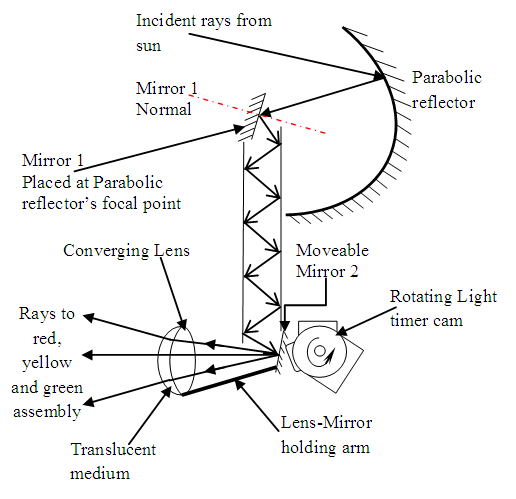 | Figure 1. shows the propagation of sun rays through the device |
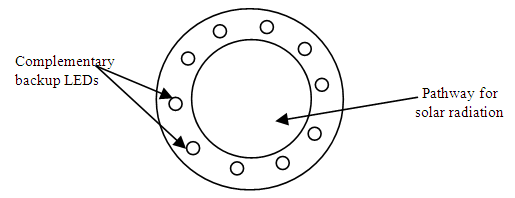 | Figure 2. LEDs arrangement for complementing abrupt loss of sun rays for each color session |
3. Results and Discussion
- The designed prototype was observed to produce significant illumination for the traffic light color sessions as early as around 6am during cloudless days. Maximum intensity of the display’s illumination was reached at around 9am and maintained to beyond 6pm on bright and cloudless days during the period of testing and deployment. This steady and constant lighting source from the sun allowed for the illumination of the traffic light system for more than thirteen hours on bright sunny days. This action resulted to significant energy savings of over 54.2% of power consumption for an equivalent traffic light system that depends on grid electricity power only on a normal cloudless day. The various colors of the green, yellow (amber) and red color sessions where preserved during operation from morning to evening time since the screens where designed with a translucent material to allow for adequate light spreading to the viewers or drivers utilizing the design. The problem of excessive heating in the device by the radiant energy of the sun was reduced by the provision of a cooling fan that operates on an intermittent pulsed supply of a regulated 8V DC. This helps to aerate the unit during high humidity days by powering on every one minutes interval for twenty seconds duration. The designed electronic circuitry also provided the voltage requirement to drive the 8V DC stepper motor used to provide a controlled rotation for the cam arm which is responsible for creating the color changing sessions. During operation, the various sections of the device operate asynchronously such that uniformity in displayed information is maintained. For instance, to attain the red-light duration, (see the schematic illustration as shown in Fig. 3) at position 1 of the cam arm control, the moveable mirror 2 is initially set to Red position for the duration of 60 seconds of stepper motor pulse provided by the DC voltage. The resultant reflected ray from the Lens-mirror arrangement is coupled to the red colored screen at a 15° angle. The rotation of the motor in the next series of pulses allows the cam arm with a higher protrusion to push the moveable mirror farther away from its original position, thereby making the reflected rays to be further inclined towards the yellow screen for a further duration of 20 seconds. This inclination was measured to be 30° degrees to the middle screen yellow color. During these short 20 seconds phase, all incident rays after reflection are directed through the converging lens unto the yellow screen at 45° angle to the mirror normal. This phase of operation is shown in Fig. 4. Viewers or drivers can see the changed color on the front of the traffic light screen for the duration of the pulse to the stepper motor. The final phase of the timing session by the stepper motor is the production of the green light by the further rotation of the cam arm during the final pulses of the stepper motor as it completes one full revolution. During this phase, as shown in Fig. 5, the inclination of the moveable mirror reaches its final allowable extension or displacement while allowing all resultant reflected rays to proceed through the green color screen for 60 seconds. A highly flexible and dedicated spring with capability to perform reliable extensions and returns while obeying Hooke’s law at all times was selected for this task as reliability is of paramount importance. The inclined rays reach the green colored screen at 60° angle to the mirror normal and provide the color duration for a ‘Go’ in a deployed use of the device. The geometric dimensions of the traffic light and its corresponding displays have been arranged so as to harness the property of the rectilinear propagation of light in the sun’s normal trajectory path of moving from east to west conventionally.
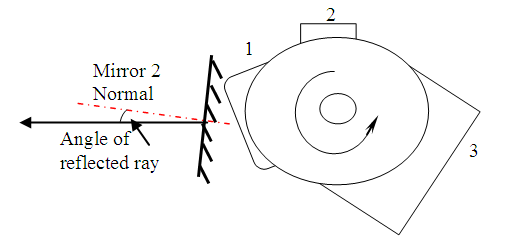 | Figure 3. Shows the production of the Red timing session by mirror inclination |
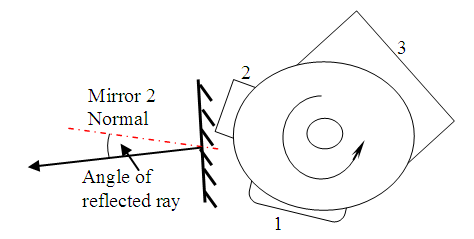 | Figure 4. Shows the production of the Yellow timing session by further mirror inclination |
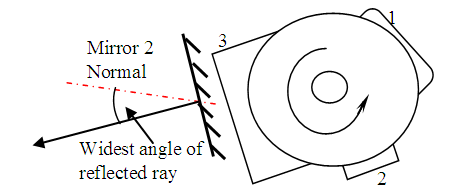 | Figure 5. shows the production of the Green timing session by the furthest mirror inclination |
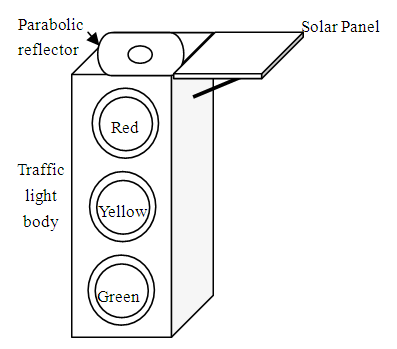 | Figure 6. Shows the schematic of designed system |
4. Conclusions
- In other to fully deploy energy efficient systems for power optimizations of both on-grid and off-grid systems, a part of the enormous energy embedded in sun rays was harnessed directly in providing illumination for traffic lighting systems. The rectilinear propagation of light and light’s reflectivity was used to provide a careful and safe illumination for lighting the traditional colors of red, yellow (amber) and green timings for a traffic light system. The resulting optoelectronic system was found to provide over 54% of significant energy savings required in powering an equivalent electrically powered traffic light system while providing improved illumination especially in sunny days with minimum cloud cover.A controlled timing regime was created by the action of an 8V DC electronic pulse powered stepper motor that rotates an attached cam with three different protrusions. The protruding parts which differed in lengths and heights were used to displace a moveable mirror that received the instantaneous radiated and multiple reflected rays of the sun through the device. This displacement caused a controlled lighting of the red, yellow and green lights or output screens of the traffic light system designed to investigate the technology. The design was found to preserve the usual colors and timings of typical traffic lights already in use or deployments in major towns and cities. The excessive heating created by the radiant energy of the sun through the device was conducted into the ambient surroundings by the provision of the 8V DC powered cooling fan that operates intermittently during highly humid conditions. The significant energy savings of the designed system could be channeled to other load needs in the future smart cities and the design hold promises of integration with already existing traffic lighting system’s hardware and architecture. Effects of accompanying solar radiation resulting from the direct use of sun rays were cushioned by the provision of the translucent output screens and their coloration. A complementary provision for LEDs lighting and their arrangement was provided to help maintain illumination of the traffic light during periods of sudden low solar intensities due to cloud cover, rain and solar eclipse with a LDR providing the light intensity threshold and control for the LEDs to switch on.
5. Recommendations
- This system can be further developed to operate completely without electricity, if that is the aim of a further research on solar energy optimization by using ambient temperature cooling with air inlets and outlets for the casing and a rotating mechanical-based timing sequence mechanism to provide the require timing and control for displacing mirror 2. Also, an optical fiber with a high damage control threshold could be used to replace the rectangular tube for improve light transmission for less bright or cloudy conditions. Also, high durable and long-lasting batteries could power the complementing LEDs to eliminate the need for solar panel power during harsh weather.
Highlights
- The abundant radiance from the sun was harnessed in designing energy efficient traffic lights. The rectilinear propagation of light rays through different media was utilized in the smart system. A timing sequence for the red, yellow and green lights was obtained by a rotating Cam mechanism. A backup lighting for fluctuating sun rays intensity was obtained from an electronic circuitry.
 Abstract
Abstract Reference
Reference Full-Text PDF
Full-Text PDF Full-text HTML
Full-text HTML